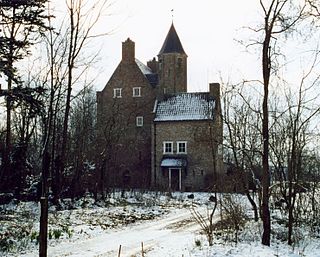
Heemskerk is a municipality and a town in the Netherlands, in the province of North Holland. It is located in the Kennemerland region.

Oostkamp is a municipality located in the Belgian province of West Flanders. The municipality comprises the villages of Hertsberge, Oostkamp proper, Ruddervoorde and Waardamme. On January 1, 2019, Oostkamp had a total population of 23,698. The total area is 79.65 km² which gives a population density of 289 inhabitants per km².

The Hook and Cod wars comprise a series of wars and battles in the County of Holland between 1350 and 1490. Most of these wars were ostensibly fought over who should hold the title of "Count of Holland", but some have argued that the underlying reason was a power struggle conducted by the bourgeois in the cities against the ruling nobility.

Santpoort-Noord or North Santpoort is a village in the municipality of Velsen in the Dutch province of North Holland. It lies about 6 km north of Haarlem.

The Battle of Zwartewaal was a decisive naval battle during the Hook and Cod wars.

Egmond Castle, also called the Ruins of Egmond, is a ruined medieval castle in the Dutch province of North Holland. It is located in Egmond aan den Hoef in the municipality of Bergen and lies about 7 kilometres (4.3 mi) west of Alkmaar. The castle dates from the 11th century and is the ancestral seat of the Egmond family, whose members became sovereign Dukes of Guelders, Counts of Egmond and Princes of Gavere, Counts of Buren and Leerdam. It is a national monument of the Netherlands.

Dirk III van Brederode was lord of Brederode.

John II, Lord of Polanen was Lord of Polanen, Lord of De Lek and Lord of Breda.

John I, Lord of Polanen was Lord of Polanen, and Lord of De Lek.

Slot Assumburg is a castle in the east of Heemskerk in the province of North Holland in the Netherlands.

Oud Haerlem Castle was a very strong castle in Holland. In 1351 it was demolished after a long siege.

The Cod Alliance Treaty was a 1350 or 1351 treaty by which a number of nobles and cities allied with William V of Holland against his mother Margaret II, Countess of Hainaut and her allies. It was signed in the first phase of the Hook and Cod wars.

Dirk III van Wassenaar was Heer van Wassenaar and burggraaf (burgrave) of Leiden.

Philips III van Wassenaer was an oldest son of the main branch of the Dutch noble family Van Wassenaer.

Gerard (III) van Heemskerk, Lord of Heemskerk was a leader of the Cod Alliance during the opening phases of the Hook and Cod wars

Floris I van Haamstede was Lord of Haamstede Castle on Schouwen, and of several other areas in Zeeland, Netherlands.

Wolfert II van Borselen was lord of Veere and Zandenburg.

Moermond Castle is a castle in Renesse on Schouwen-Duiveland.

Sabbinge Castle is a small castle in Oud-Sabbinge, on the former island Wolphaartsdijk

Philips I, Lord of Polanen became Lord of Polanen in 1345. He later became Lord of Capelle, Nieuwerkerk, and Uyterlier. Philips was an important commander during the Hook and Cod wars.






















